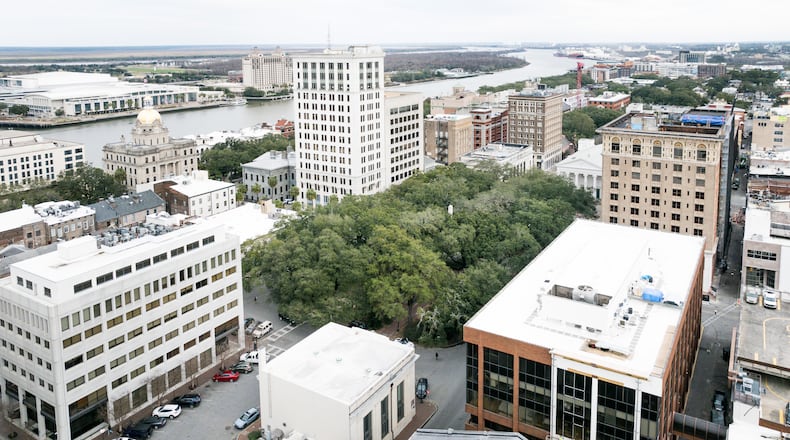SAVANNAH ― Johnson Square is more business than leisure, the outlier in this tourism hub. Instead of hotels, restaurants and shops, Johnson is flanked by banks and office buildings.
Just not for much longer.
This epicenter of Savannah’s central business district will soon see two large office buildings become luxury hotels. Speculation is one or more of the other three office centers could follow suit.
The trend extends across the 1-square-mile National Landmark Historic District, with three other office buildings converting to hotels. Those redevelopments have squeezed an already tight market and triggered a different kind of post-COVID office space crisis — too little availability instead of too much.
Whereas Atlanta and many other population centers are littered with empty office towers and parks — Atlanta’s vacancy rate is 16.6% officially but closer to 30% when unwanted sublease space is figured in — Savannah’s vacancy rate is 2.1%. Like-sized Georgia cities such as Augusta, Macon, Athens and Columbus are all above 6%.
Credit: Justin Taylor for The Atlanta Journal Constitution
Credit: Justin Taylor for The Atlanta Journal Constitution
Madelyn Bearn, associate director of market analytics at the real estate data and services firm CoStar, said Savannah’s vacancy rate is a rarity across the country. She said demand is outpacing supply “at a time when office vacancies have soared nationally.”
The space crunch won’t abate anytime soon. Only 102,000 square feet is in the development pipeline for Savannah, Bearn said.
Calls to action
Savannah is a growing magnet for tourists attracted to its tree-draped squares and architecturally stunning homes, buildings and waterfront. Visitor numbers topped 17 million in 2023, up from 13 million a decade earlier. The interest has spawned billions of dollars in new hotel investment, including luxury chains.
But the coastal city is more than a tourism boomtown. Savannah’s port is the nation’s third-busiest for cargo containers and the metro area is a national player in economic development projects, such as the Hyundai electric vehicle plant.
The demand for office space never dipped in Savannah as it did elsewhere in the country, even as the supply squeeze pushed average rents to $27.58 per square foot — less than a $2 discount compared with Atlanta, home to glitzy towers and several Fortune 500 companies.
Visions for addressing the problem don’t match, at least at this point. Government officials see opportunity for office space infill around downtown’s edges in still-developing areas, such as the 54-acre Eastern Wharf along the Savannah River and the Canal District anchored by the now 3-year-old Enmarket Arena.
Credit: Justin Taylor for The Atlanta Journal Constitution
Credit: Justin Taylor for The Atlanta Journal Constitution
Offices will bring high volumes of people to those areas, sparking retail and residential growth.
“We’re not facing the same challenges that other large cities are who’ve lost their professional service workforce to telework and are struggling to understand what they’re going to do with those large buildings,” said Savannah City Manager Jay Melder, the city government’s chief executive. “We have a demand and we’re starting to see the market respond to that in some interesting ways.”
Some business leaders, particularly those who work downtown, would prefer Savannah take steps to protect the office space that’s left in the central business district. Even the Tourism Leadership Council, or TLC, a hospitality industry trade group that counts most local hotel leaders among its members, issued a statement in mid-February encouraging city government officials to consider a local ordinance to prohibit converting existing office space into lodging.
Developers have zeroed in on converting office buildings into hotels because of another ordinance, a 2019 law that restricts where hotels can be located within the historic district. Known as the Hotel Overlay Map, the zoning was drawn up largely to ensure the district maintains a residential population and to confine redevelopment to more business-centric areas — such as Johnson Square.
Hotels replacing offices is that ordinance’s unintended consequence and has resulted in blowback against the city’s tourism industry, whose leaders have long been accused of attempting to turn downtown into a theme park. Even their recent statement opposing office conversions into hotels is viewed with suspicion: Encouraging government action to limit future hotels would ostensibly reduce competition for current hoteliers, many of whom are TLC members.
Adding to the public skepticism is that the organization’s board chair, Pritpal Singh, is involved in the conversion of one of the Johnson Square office buildings, albeit one that is returning to its original use. The Manger, on the southeast edge of the square, was built as a hotel that opened in 1912 and converted to offices in 1977.
Credit: Justin Taylor for The Atlanta Journal Constitution
Credit: Justin Taylor for The Atlanta Journal Constitution
The TLC’s president insists their motivation is not sinister. Office spaces for professionals, such as doctors, lawyers and bankers, are necessary for downtown to remain livable and relevant as a central business district. Sacrificing that in the name of more hotel rooms would be a detriment to Savannah tourism.
“Visitors come here because they want to experience a living, breathing urban environment that has a sense of place,” TLC President Michael Owens said. “You lose that, you lose what makes you special, and you lose your tourism business.”
Mayor seeks ‘balance’
Owens’ sentiment is one shared by city leaders, including Mayor Van Johnson. He’s served in elected office with the city since 2004 and witnessed the downtown renaissance. Now in his second term as mayor, he’s made quality of life in the Historic District a priority, pushing for restrictions on tour trolleys and walking tour operators.
He too sees the office-to-hotel trend as worrisome and said the dearth of office space is being considered as part of the city’s strategic planning work. Yet he stopped short of committing to zoning changes to address the issue.
“It’s a good problem to have, because there are some cities where nobody wants to live, nobody wants to work and nobody wants to play,” Johnson said. “It’s a balancing act, and so we will balance it.”
Credit: Justin Taylor for The Atlanta Journal Constitution
Credit: Justin Taylor for The Atlanta Journal Constitution
Keep Reading
The Latest
Featured







